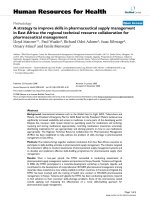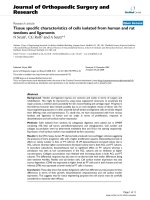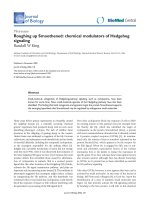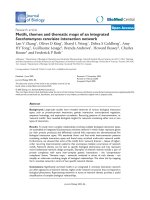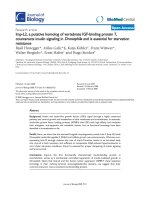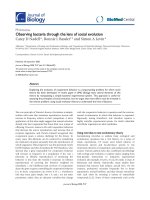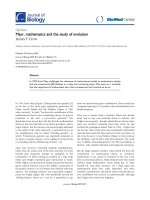Báo cáo sinh học: "Tissue specific promoters improve specificity of AAV9 mediated transgene expression following intra-vascular gene delivery in neonatal mice" pptx
Bạn đang xem bản rút gọn của tài liệu. Xem và tải ngay bản đầy đủ của tài liệu tại đây (292.12 KB, 5 trang )
BioMed Central
Page 1 of 5
(page number not for citation purposes)
Genetic Vaccines and Therapy
Open Access
Short paper
Tissue specific promoters improve specificity of AAV9 mediated
transgene expression following intra-vascular gene delivery in
neonatal mice
Christina A Pacak
†
, Yoshihisa Sakai
†
, Bijoy D Thattaliyath, Cathryn S Mah*
and Barry J Byrne*
Address: Powell Gene Therapy Center, College of Medicine, University of Florida, 1600 SW Archer Road, Gainesville, FL 32610-0266, USA
Email: Christina A Pacak - ; Yoshihisa Sakai - ; Bijoy D Thattaliyath - ;
Cathryn S Mah* - ; Barry J Byrne* -
* Corresponding authors †Equal contributors
Abstract
The AAV9 capsid displays a high natural affinity for the heart following a single intravenous (IV)
administration in both newborn and adult mice. It also results in substantial albeit relatively lower
expression levels in many other tissues. To increase the overall safety of this gene delivery method
we sought to identify which one of a group of promoters is able to confer the highest level of
cardiac specific expression and concurrently, which is able to provide a broad biodistribution of
expression across both cardiac and skeletal muscle. The in vivo behavior of five different promoters
was compared: CMV, desmin (Des), alpha-myosin heavy chain (α-MHC), myosin light chain 2
(MLC-2) and cardiac troponin C (cTnC). Following IV administration to newborn mice, LacZ
expression was measured by enzyme activity assays. Results showed that rAAV2/9-mediated gene
delivery using the α-MHC promoter is effective for focal transgene expression in the heart and the
Des promoter is highly suitable for achieving gene expression in cardiac and skeletal muscle
following systemic vector administration. Importantly, these promoters provide an added layer of
control over transgene activity following systemic gene delivery.
Findings
When developing gene therapy, it is important to mini-
mize adverse responses to protein expression in unneces-
sary sites by restricting transgene expression to areas
where it is most desirable. This confinement can be tissue
restricted expression such as in the heart, or limited
expression to a combination of tissues such as those
affected in the muscular dystrophies.
One way to control the site of transgene expression is
through choice of physical delivery route [1]. Direct injec-
tions into a specific tissue help to concentrate transduc-
tion to that exact location. However, it is often difficult to
achieve a broad and even biodistribution of expression
across an entire organ. Adeno-associated virus (AAV) has
emerged as an extremely versatile vehicle for gene delivery
due to its persistence and ability to transduce a variety of
tissues [2-5]. Investigators have demonstrated successful
intravenous (IV) AAV delivery via the superficial temporal
vein in newborn mice or the jugular vein, portal vein and
tail vein in adult mice [6-9]. Systemic IV delivery routes
are particularly well suited when an extensive biodistribu-
tion of transgene expression is advantageous. In order to
achieve thorough perfusion in one specific tissue but not
Published: 23 September 2008
Genetic Vaccines and Therapy 2008, 6:13 doi:10.1186/1479-0556-6-13
Received: 10 June 2008
Accepted: 23 September 2008
This article is available from: />© 2008 Pacak et al; licensee BioMed Central Ltd.
This is an Open Access article distributed under the terms of the Creative Commons Attribution License ( />),
which permits unrestricted use, distribution, and reproduction in any medium, provided the original work is properly cited.
Genetic Vaccines and Therapy 2008, 6:13 />Page 2 of 5
(page number not for citation purposes)
throughout the entire body, greater control may be
required.
In addition to the physical delivery route, another way to
confine expression is by choosing a gene delivery vehicle
with a high natural tropism for the tissue of interest. Sev-
eral groups have demonstrated the unique ability of the
AAV9 capsid to yield extraordinarily high levels of trans-
gene expression in the heart [8-11]. Each of these groups
using their respective delivery routes and detection sys-
tems also observed various levels of expression in other
tissues. These data demonstrate that selection of a partic-
ular delivery vehicle alone is not enough to isolate trans-
gene expression.
One approach to further increase specificity is to select a
promoter that naturally drives expression of a particular
gene in the tissue/s of interest. The objective of the current
study was to identify which one of a group of promoters
confers the greatest degree of cardiac specific expression
and concurrently, which provides a broad biodistribution
of expression across both cardiac and skeletal muscle.
Five promoters were compared: cytomegalovirus immedi-
ate-early gene promoter (CMV), human desmin (Des),
human alpha-myosin heavy chain (α-MHC), rat myosin
light chain 2 (MLC-2) and human cardiac troponin C
(cTnC) (Figure 1A). Each promoter-LacZ construct was
flanked by the inverted terminal repeats of AAV2 and
packaged into the AAV9 capsid to yield rAAV2/9-pro-
moter-LacZ. The constructs were tested by transfection
and subsequently infection of both differentiated and
undifferentiated C2C12 cells and a previously described
immortalized cardiomyocyte line [12] to confirm pro-
moter function (data not shown).
The CMV construct (690 base pairs [bp]) used in these
experiments was from Stratagene
®
(rAAV2/9-CMV-LacZ).
It contains 5 cyclic AMP response-element binding pro-
tein (CRE-BP – a member of the leucine zipper family of
transcription factors) binding sites as well as 4 NFkappaB
binding sites. The CMV promoter confers virtually ubiqui-
tous expression throughout the body except in the liver
where it becomes inactive once the initial inflammatory
phase passes [13]. The goal of this study was to identify
alternatives to the CMV promoter.
The human desmin construct (354 bp) described in this
study (rAAV2/9-Des-LacZ) contains both a myocyte spe-
cific enhancer factor 2 (MEF2) and a MyoD enhancer ele-
ment. A TATA box was also added to increase
transcription specificity. The primers were designed using
the Catalogue of Regulatory Elements [14]. This promoter
normally drives expression of desmin, a major intermedi-
ate filament protein essential for maintaining the func-
tional and structural integrity of muscle [15]. Analysis of
human tissues has revealed desmin expression in cerebel-
lum, endometrium, skeletal muscle, neuronal cells of the
lateral ventricle and heart [16]. Desmin may be a useful
promoter to incorporate when performing systemic trans-
gene delivery in myopathies. Diverse targets could include
cardio skeletal muscle and even neurons.
The human α-MHC promoter (363 bp) (rAAV2/9-α-
MHC-LacZ) construct contains a MEF2 region, a PRE-D
sequence (tandem GATA sites separated by 4 bp), and 2
CArG elements. The primers were designed using the Cat-
alogue of Regulatory Elements [14]. Myosin heavy chain
is the most abundant component of the cardiac sarcomere
[17]. We therefore hypothesized that it would be a highly
specific cardiac promoter. The α-MHC protein is a "fast"
ATPase myosin and is located in the thick filaments of
myofibrils. It is important for cardiomyocyte contraction
and relaxation [18]. In mice, the α-MHC protein is
expressed in cardiac atrium and ventricles as well as skel-
etal muscle. In humans, α-myosin expression is restricted
to the atria, and the β-MHC isoform ("slow" ATPase
myosin) is the most predominant in ventricles [17]. Pre-
vious in vitro experiments with rat neonatal cardiomyo-
cytes and mouse studies have shown that the MHC
promoter preferentially expresses in cardiac tissue more
than skeletal muscle [19].
The promoter incorporated into the rat MLC construct
described here, (479 bp) (rAAV2/9-MLC-LacZ) has been
previously described by Henderson et. al. and was origi-
nally designed from cardiac MLC-2 [20]. While various
isoforms exist, the cardiac MLCs can be divided into 2
types: MLC-1, non-phosphorylatable and MLC-2, phos-
phorylatable. Ca
2+
dependent phosphorylation of MLC-2
by MLC kinase provides an important a regulatory func-
tion in the contraction of cardiac, skeletal and smooth
muscle [20]. Two different isoforms of MLC-2 are typi-
cally expressed in the atria and ventricles of the mamma-
lian heart during embryonic development and
maturation, and later in the adult heart [21]. The rat-
derived MLC promoter characterized here contains a
CArG box as well as a MyoD enhancer sequence.
The human cTnC construct (rAAV2/9-cTnC-LacZ) (175
bp) contains 2 cardiac enhancer factor (CEF) sites. The
primers for this promoter were designed using the Cata-
logue of Regulatory Elements [14]. The CEF sites of the
human cTnC bind cardiac specific nuclear proteins [22].
CEF-1 specifically binds the GATA-4 protein in addition
to a currently uncharacterized nuclear protein complex
that is also bound by CEF-2. The cardiac troponin C
(cTnC) gene produces identical transcriptsin both slow
twitch skeletal muscle as well as the heart. It binds Ca
2+
and prevents actin-myosin interaction in resting muscle.
Genetic Vaccines and Therapy 2008, 6:13 />Page 3 of 5
(page number not for citation purposes)
Figure 1 (see legend on next page)
Genetic Vaccines and Therapy 2008, 6:13 />Page 4 of 5
(page number not for citation purposes)
We hypothesized that elements from the troponin pro-
moter, which is found in both heart and skeletal muscle,
would drive expression in all striated muscle.
BALB/c neonatal mice received 5 × 10
10
vector genomes
(vg) of each vector via single injections to the superficial
temporal vein (n = 6 per promoter group). After 4 weeks
the tissues were harvested and expression levels were eval-
uated by β-galactosidase enzyme assay. The highest levels
of expression were observed in hearts of animals injected
with the CMV, Des or α-MHC constructs (Figure 1B).
Expression levels in hearts of animals injected with viruses
containing either the MLC-2 or cTnC promoters were
comparatively weak.
Analysis of expression in skeletal muscles including the
diaphragm (Figure 1C) revealed the strongest β-galactosi-
dase expression levels were from the Desmin promoter.
The CMV promoter showed the next highest expression
levels followed by the other promoters. Analysis of non-
heart, non-skeletal muscle tissues (Figure 1D) showed
that the Des promoter produced the highest expression
levels in the brain.
Comparing biodistribution profiles of each promoter
individually showed that of those included in this study,
the α-MHC is the most cardiac specific (Figure 1E) and the
Des construct is well suited for achieving transgene expres-
sion in both heart and skeletal muscle (Figure 1F). Impor-
tantly, the Des promoter also showed expression levels in
the brain that were similar to those found in muscle. This
is a key attribute when gene therapy is applied to Pompe
Disease where a neuronal as well as a muscular compo-
nent has been observed [7].
The biodistribution of viral vector genomes from mice
injected with the Des construct was assessed by real time
PCR on DNA isolated from each tissue. This measurement
is indicative of viral genome location and is independent
of the specific promoter being delivered. The vector
genome biodistribution profile was very similar to that
previously described for AAV9 [8] confirming that the var-
iance in expression profiles result from the different pro-
moters being employed. Heart contained the highest
concentration at 19 ± 2 copies per cell followed by the dia-
phragm with approximately 0.13 ± 0.007 copies per cell.
All other tissues contained less than 0.01 copies per cell.
Ultimately, these data serve as a characterization of 5 dif-
ferent promoters and their respective behavior in vivo fol-
lowing AAV9 mediated gene delivery. Our data indicate
that the α-MHC promoter confers the most cardiac spe-
cific expression and that the Des promoter provides
expression in a variety of tissues. The combined use of
application tailored promoters and delivery vehicles with
well-understood tropisms augment the control investiga-
tors have over expression of their transgene of interest and
thereby increase the over-all safety of therapeutic gene
delivery.
Competing interests
The Johns Hopkins University, the University of Florida,
B.J.B., C.A.P., and C.S.M. could be entitled to patent roy-
alties for inventions described in this article.
A) Construct DiagramsFigure 1 (see previous page)
A) Construct Diagrams. Promoters were switched into the backbone by replacement of the CMV promoter between the first
NotI and AgeI sites. The Des construct was created using primers against human genomic DNA (forward [F] Des enhancer
primer containing NotI) ATA AGA ATG CGG CCG CAC CCA TGC CTC CTC AGG TA, (reverse [R] Des enhancer primer
containing XhoI) CCG CTC GAG GGT GGG GCC TCA AGT TTA T, ([F] Des promoter primer containing XhoI) CCG CTC
GAG ATA ACC AGG GCT GAA AGA, ([R] Des promoter primer containing AgeI) TGTA CCG GTG ACG GCG CGG GCG
AGG CT. The α-MHC construct was created by amplifying human genomic DNA: ([F] containing NotI) ATA AGA ATG CGG
CCG CCC AGT TGT TCA ACT CAC CCT TCA and ([R] containing AgeI) TGT ACC GGT GGG TTG GAG AAA TCT CTG
ACA GCT. The MLC-2 construct was created by replacing the backbone with the previously described rat MLC-2 pro-
moter[20]. ([F] containing NotI) ATA AGA ATG CGG CCG CGA CCC AGA GCA CAG AGC ATC GT ([R] containing AgeI)
TGT ACC GGT GAA TTC AAG GAG CCT GCT. The cTnC construct was created by amplifying human genomic DNA: ([F]
containing Not1) ATA AGA ATG CGG CCG CCA GCC TGA GAT CAC TGG GAC CAG A ([R] containing Age1) TGT
ACC GGT CCA TGC TGG CGG CTC ACA GGA. 5 × 10
10
vg/mouse was administered (n = 6 per promoter group) [23]. Tis-
sue lysates were assayed using the Galacto-Star chemiluminescence reporter gene assay system (Tropix, Inc., Bedford, MA,
USA). Protein concentrations were determined using the Bio-Rad DC protein assay kit (Bio-Rad, Hercules, CA, USA). B) β-
galactosidase (β-gal) expression levels show that CMV provides the greatest amount of expression in the heart followed by
Des and α-MHC. C) β-gal levels in skeletal muscle including the diaphragm were highest in mice that were administered the
Des construct. (Di, diaphragm; Qu, quadriceps; So, soleus; ED, extensor digitorum longus; TA, tibialis anterior; Ga, gastrocne-
mius) D) Evaluation by β-gal assay of non-heart, non-skeletal muscle tissues revealed highest expression levels in brain and lung
from mice injected with the Des construct. (Ht, heart; Br, brain; Lu, lung; Li, liver; Sp, spleen; Ki, kidney; SI, small intestine) E)
and F) β-gal levels and biodistribution profiles from α-MHC and Des construct injected mice (respectively).
Publish with BioMed Central and every
scientist can read your work free of charge
"BioMed Central will be the most significant development for
disseminating the results of biomedical research in our lifetime."
Sir Paul Nurse, Cancer Research UK
Your research papers will be:
available free of charge to the entire biomedical community
peer reviewed and published immediately upon acceptance
cited in PubMed and archived on PubMed Central
yours — you keep the copyright
Submit your manuscript here:
/>BioMedcentral
Genetic Vaccines and Therapy 2008, 6:13 />Page 5 of 5
(page number not for citation purposes)
Authors' contributions
CAP participated in the design of the study, performed the
injections, ran the β-galactosidase enzyme detection
assays and drafted the manuscript. YS designed and
cloned the plasmids and harvested tissues. BDT per-
formed the RNA transcript analysis and helped to draft the
manuscript. CSM participated in the design of the study
and helped to draft the manuscript. BJB participated in the
design of the study and reviewed the manuscript. All
authors read and approved the final manuscript.
Acknowledgements
We would like to express our gratitude to Mark Potter, the University of
Florida Powell Gene Therapy Center (PGTC) and Irene Zolotukhin for
providing technical expertise in producing the viruses used in this study.
We would also like to thank Stacy Porvasnik for assisting with animal work
and Dr. Steven Potter (Children's Hospital Medical Center, Cincinnati,
Ohio) for providing the immortalized line of cardiomyocytes. This work
was supported in part by an American Heart Association Pre-doctoral Fel-
lowship Award-Florida and Puerto Rico Affiliate (to CAP), the NIH
National Heart, Lung, and Blood Institute grant PO1 HL59412; National
Institute of Diabetes and Digestive and Kidney Diseases grant PO1
DK58327; AT-NHLBI-U01 HL69748; and the AHA National Center (to
C.S.M.).
References
1. Thierry AR, Lunardi-Iskandar Y, Bryant JL, Rabinovich P, Gallo RC,
Mahan LC: Systemic gene therapy: biodistribution and long-
term expression of a transgene in mice. Proc Natl Acad Sci USA
1995, 92:9742-9746.
2. Clark KR, Sferra TJ, Johnson PR: Recombinant adeno-associated
viral vectors mediate long-term transgene expression in
muscle. Hum Gene Ther 1997, 8:659-669.
3. Kessler PD, Podsakoff GM, Chen X, McQuiston SA, Colosi PC, Mat-
elis LA, Kurtzman GJ, Byrne BJ: Gene delivery to skeletal muscle
results in sustained expression and systemic delivery of a
therapeutic protein. Proc Natl Acad Sci USA 1996, 93:14082-14087.
4. Podsakoff G, Wong KK Jr, Chatterjee S: Efficient gene transfer
into nondividing cells by adeno-associated virus-based vec-
tors. J Virol 1994, 68:5656-5666.
5. Xiao X, Li J, Samulski RJ: Efficient long-term gene transfer into
muscle tissue of immunocompetent mice by adeno-associ-
ated virus vector. J Virol 1996, 70:8098-8108.
6. Mah C, Cresawn KO, Fraites TJ Jr, Pacak CA, Lewis MA, Zolotukhin
I, Byrne BJ: Sustained correction of glycogen storage disease
type II using adeno-associated virus serotype 1 vectors. Gene
Ther 2005, 12:1405-1409.
7. Mah C, Pacak CA, Cresawn KO, Deruisseau LR, Germain S, Lewis
MA, Cloutier DA, Fuller DD, Byrne BJ: Physiological Correction
of Pompe Disease by Systemic Delivery of Adeno-associated
Virus Serotype 1 Vectors. Mol Ther 2007, 15:501-507.
8. Pacak CA, Mah CS, Thattaliyath BD, Conlon TJ, Lewis MA, Cloutier
DE, Zolotukhin I, Tarantal AF, Byrne BJ: Recombinant adeno-
associated virus serotype 9 leads to preferential cardiac
transduction in vivo. Circ Res 2006, 99:e3-9.
9. Inagaki K, Fuess S, Storm TA, Gibson GA, McTiernan CF, Kay MA,
Nakai H: Robust systemic transduction with AAV9 vectors in
mice: efficient global cardiac gene transfer superior to that
of AAV8. Mol Ther 2006, 14:45-53.
10. Sarkar R, Mucci M, Addya S, Tetreault R, Bellinger DA, Nichols TC,
Kazazian HH Jr: Long-term efficacy of adeno-associated virus
serotypes 8 and 9 in hemophilia a dogs and mice. Hum Gene
Ther 2006, 17:427-439.
11. Vandendriessche T, Thorrez L, Acosta-Sanchez A, Petrus I, Wang L,
Ma L, L DEW, Iwasaki Y, Gillijns V, Wilson JM, et al.: Efficacy and
safety of adeno-associated viral vectors based on serotype 8
and 9 vs. lentiviral vectors for hemophilia B gene therapy. J
Thromb Haemost 2007, 5:16-24.
12. Brunskill EW, Witte DP, Yutzey KE, Potter SS: Novel Cell Lines
Promote the Discovery of Genes Involved in Early Heart
Development. Developmental Biology 2001, 235:507-520.
13. Loser P, Jennings GS, Strauss M, Sandig V: Reactivation of the pre-
viously silenced cytomegalovirus major immediate-early
promoter in the mouse liver: involvement of NFkappaB. J
Virol 1998, 72:180-190.
14. Catalogue of Regulatory Elements [ />MTIR/TOC.html]
15. Paulin D, Li Z: Desmin: a major intermediate filament protein
essential for the structural integrity and function of muscle.
Exp Cell Res 2004, 301:1-7.
16. Wallenberg : Human Protein Atlas. 2006.
17. James J, Osinska H, Hewett TE, Kimball T, Klevitsky R, Witt S, Hall
DG, Gulick J, Robbins J: Transgenic over-expression of a motor
protein at high levels results in severe cardiac pathology.
Transgenic Res 1999, 8:9-22.
18. Kim SJ, Iizuka K, Kelly RA, Geng YJ, Bishop SP, Yang G, Kudej A,
McConnell BK, Seidman CE, Seidman JG, Vatner SF: An alpha-car-
diac myosin heavy chain gene mutation impairs contraction
and relaxation function of cardiac myocytes. Am J Physiol 1999,
276:H1780-1787.
19. Aikawa R, Huggins GS, Snyder RO: Cardiomyocyte-specific gene
expression following recombinant adeno-associated viral
vector transduction. J Biol Chem 2002, 277:18979-18985.
20. Henderson SA, Spencer M, Sen A, Kumar C, Siddiqui MA, Chien KR:
Structure, organization, and expression of the rat cardiac
myosin light chain-2 gene. Identification of a 250-base pair
fragment which confers cardiac-specific expression. J Biol
Chem 1989, 264:18142-18148.
21. Kelly R, Buckingham M: Manipulating myosin light chain 2 iso-
forms in vivo: a transgenic approach to understanding con-
tractile protein diversity. Circ Res 1997, 80:751-753.
22. Ip HS, Wilson DB, Heikinheimo M, Tang Z, Ting CN, Simon MC, Lei-
den JM, Parmacek MS: The GATA-4 transcription factor trans-
activates the cardiac muscle-specific troponin C promoter-
enhancer in nonmuscle cells. Mol Cell Biol 1994, 14:7517-7526.
23. Sands MS, Barker JE: Percutaneous intravenous injection in
neonatal mice. Lab Anim Sci 1999, 49:328-330.
